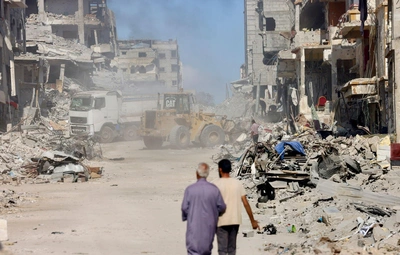Rubble, Fear, & Poverty: Tragedy haunting Gaza’s displaced after ceasefire
When the ceasefire was announced on October 10, life briefly flickered back into the hearts of Gaza’s displaced.
Tent camps filled with shy ululations, and hesitant smiles appeared—fragile and fleeting, like the truce itself.
Yet, the joy of survival soon evaporated before a reality heavier than war: one ruled by a grim trinity—fear, rubble, and poverty.
Returning house is no longer a simple journey back to place—it is a test of courage against the unknown. Between houses turned to ruins, areas declared military zones, and the constant threat of renewed Israeli bombardment, tens of thousands of displaced Gazans wait at the gates of uncertainty, clutching the keys of houses that no longer exist, and memories still burning beneath the dust.
In a shelter camp west of Deir al-Balah, Umm Mohammed Mansour (39) sits before her tent, silently watching her three children play in the sand, as if trying to bury the war in grains of earth.
“When we heard the news about the ceasefire,” she told Palestine newspaper, “I thought the suffering was over. I hugged my children and we cried with joy. But just a few days later, the bombing returned to Rafah, and I realized the war hadn’t really ended.”
Lowering her voice, she added, “I’m afraid to go back and pay the price again. I don’t want my children to relive that terror. As long as there are no real guarantees, we’ll keep living only on the hope of return.”
Between her words hides the quiet despair shared by thousands of displaced families—people who dream of going house, yet know that between dream and reality lies a mountain of ash.
In al-Mawasi, west of Khan Younis, Khaled Nasser (46) lives in a tattered tent pieced together from aid fabrics. Sitting beside a small stove fueled with a few sticks of wood, he embodies the exhaustion of survival after two years of war.
“I want to go back to my house,” he said, “but how? Truck drivers now charge between 2,000 and 3,000 shekels to move a family from the south to Gaza City. Where would I get that kind of money? There’s no work, no money, no future in this tent.”
He smiled bitterly and added, “People think that when the war stops, the suffering ends—but for us, it’s just the beginning of another battle: the fight to stay alive. Those who have money go back. Those who don’t remain here, waiting for the unknown.”
For Samar Abu Salmiya (34), displaced from Beit Lahia in northern Gaza, the danger is even greater. Her neighborhood lies within what the Israeli army calls the “yellow zone”—an area Palestinians are forbidden to enter.
“They stop us from approaching and shoot at any vehicle that tries to get close,” she said, her voice weary. “How can we return, knowing we might die on the way?”
She pulls out an old phone and shows a photo of her destroyed house. “Even if they let us back, what would we return to? No water, no electricity, no schools. My house is a pile of rubble, and the hospital where I took my children doesn’t exist anymore.”
After a pause, her voice trembles as she adds, “Just days ago, the Shaaban family was targeted in al-Zaytoun while returning house inside the yellow zone. Eleven people were killed—seven of them children. They only wanted to go house… but they went back to death.”
Between torn tents and houses reduced to dust, Gaza’s displaced face a cruel reality: there is no safe return, and no dignified life in displacement.
Fear traps them from above, poverty chains them to the ground, and the rubble blocks every path house.
Yet, even within this relentless trinity, Gaza—true to itself—keeps trying to rise from beneath the ruins, to prove that life on this land refuses to be defeated, no matter how long the return is delayed.

